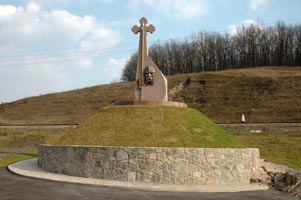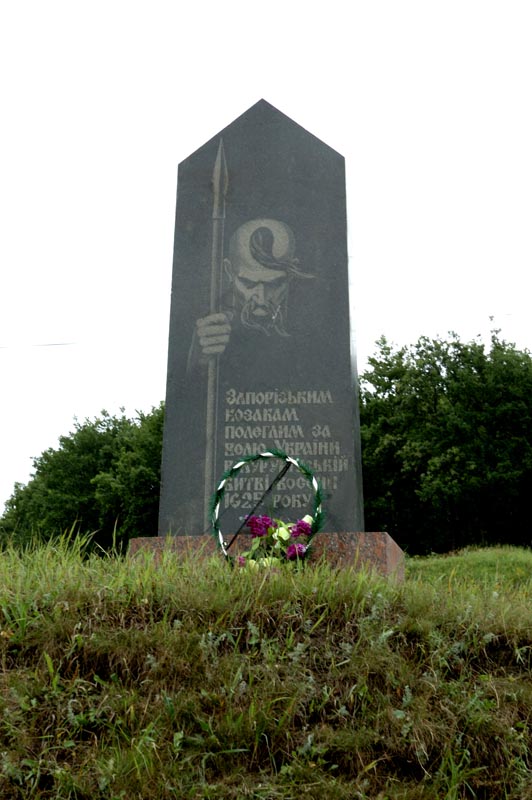
The finals of the Cossacks-Poles wars of the 16th-17th centuries took place on the territory of the historical Poltava region: the first – near Lubny, the second – near Kremenchuk, on the right bank of Kurukovo side, the third – under Hovtva. Cossack competitions between Cossacks and Poles near Kremenchuk were called the Kurukovo campaign in the scientific literature.
The Kurukovo campaign of 1625 was the central event of the Cossack uprising led by M. Zhmail. This in turn was a continuation of the long struggle of the Cossack state for their rights and privileges, which began to be actively pressured by the Polish-Lithuanian Commonwealth after the Khotyn War.
After the approach of the main forces of the Cossacks and the Crown army in Taburyshche natural landmark on the banks of the Tsybulnyk River, combat operations became rapid. Zhmailo and his colonels refused to accept the government claims, and S. Konetspolskyi and his military leaders perceived this as a trigger for the beginning of a “real” war. On 19 October, he ordered to prepare for the combat assault on the Cossack camp. The soldiers began to prepare batteries of heavy guns, knit special siege baskets (corbeils), fascines and build “siege vehicles”.
After several unsuccessful attacks, Zhmailo decided to retreat. After setting a fire in the camp, the Cossacks slipped out, leaving three detached units on the way to retreat, which were to detain the Polish cavalry.
A new Cossack camp was set up near Lake Kurukovo in the middle of the remains of ancient fortifications (so far it has not been clarified what the fortifications described in the sources are). Approaching on 21st October, the tired cavalry of S. Konetspolskyi tried to break through the Cossack camp, but the Cossacks repelled the enemy attack with cannon and rifle fire, causing significant losses on the enemy. The second attack was also unsuccessful. The battle, in which both sides suffered heavy casualties (up to 8,000 people in the Cossacks and a little less in the crown army), was over by itself.
On 24th October (3rd November 1625) negotiations began, which were led by the newly elected Hetman M. Doroshenko on behalf of the Cossacks. On 27th October, he signed the well-known Kurukovo articles, which dealt with the establishment of the Cossack register of 6,000 Cossacks, wages, output from the Cossack noble estates, prohibition of campaigns on the sea and burning by Cossacks of seagulls. Important concessions made by the Cossacks were amnesty for all rebels and refusal of the crown commissars from the extradition of officer.
Unfortunately, a complete change of landscape due to anthropogenic factors makes it impossible to link the well-documented Kurukovo campaign to the modern site of the combat operations of 1625. And although the monument has been erected in memory of the Cossacks killed in the Battle of Kurukovo on the left side of the Kremenchuk – Oleksandria road, outside Kriukov, it has a rather indirect relation to the real place of the battle.
According to historical sources the first battle of the Cossack army with government forces took place near Kryliv town (on the Tsybulnyk River, in Taburyshche natural landmark on the remains of the old fortified settlement), and is localized in the modern city of Svitlovodsk by some modern researchers. Then there were clashes of Cossack rearguards on the way of retreat of the main forces from Taburyshche to Kriukiv. At the same time, one of the two crossings, where the roadblocks were laid, probably still exists today.
But the main battle took place under the fortifications of the Cossack camp, as indicated by historical sources: in Medvezha Losa natural landmark, near the “Kuruk River” (“Lake Kurukovo” according to another source). The local researcher D. Vyrskyi theorizes that this may be the area of modern Kriukov in front of the bridge across the Dnipro River. Kurukovo Lake itself is considered to be partially dried and partially dissolved in the modern Biletsk floodplains.
But in any case, the events of 1625 in Poltava region, near the city of Kremenchuk, are forever inscribed in the military history of Ukraine as one of the most heroic episodes of struggle for its statehood.
The finals of the Cossacks-Poles wars of the 16th-17th centuries took place on the territory of the historical Poltava region: the first – near Lubny, the second – near Kremenchuk, on the right bank of Kurukovo side, the third – under Hovtva. Cossack competitions between Cossacks and Poles near Kremenchuk were called the Kurukovo campaign in the scientific literature.
The Kurukovo campaign of 1625 was the central event of the Cossack uprising led by M. Zhmail. This in turn was a continuation of the long struggle of the Cossack state for their rights and privileges, which began to be actively pressured by the Polish-Lithuanian Commonwealth after the Khotyn War.
After the approach of the main forces of the Cossacks and the Crown army in Taburyshche natural landmark on the banks of the Tsybulnyk River, combat operations became rapid. Zhmailo and his colonels refused to accept the government claims, and S. Konetspolskyi and his military leaders perceived this as a trigger for the beginning of a “real” war. On 19 October, he ordered to prepare for the combat assault on the Cossack camp. The soldiers began to prepare batteries of heavy guns, knit special siege baskets (corbeils), fascines and build “siege vehicles”.
After several unsuccessful attacks, Zhmailo decided to retreat. After setting a fire in the camp, the Cossacks slipped out, leaving three detached units on the way to retreat, which were to detain the Polish cavalry.
A new Cossack camp was set up near Lake Kurukovo in the middle of the remains of ancient fortifications (so far it has not been clarified what the fortifications described in the sources are). Approaching on 21st October, the tired cavalry of S. Konetspolskyi tried to break through the Cossack camp, but the Cossacks repelled the enemy attack with cannon and rifle fire, causing significant losses on the enemy. The second attack was also unsuccessful. The battle, in which both sides suffered heavy casualties (up to 8,000 people in the Cossacks and a little less in the crown army), was over by itself.
On 24th October (3rd November 1625) negotiations began, which were led by the newly elected Hetman M. Doroshenko on behalf of the Cossacks. On 27th October, he signed the well-known Kurukovo articles, which dealt with the establishment of the Cossack register of 6,000 Cossacks, wages, output from the Cossack noble estates, prohibition of campaigns on the sea and burning by Cossacks of seagulls. Important concessions made by the Cossacks were amnesty for all rebels and refusal of the crown commissars from the extradition of officer.
Unfortunately, a complete change of landscape due to anthropogenic factors makes it impossible to link the well-documented Kurukovo campaign to the modern site of the combat operations of 1625. And although the monument has been erected in memory of the Cossacks killed in the Battle of Kurukovo on the left side of the Kremenchuk – Oleksandria road, outside Kriukov, it has a rather indirect relation to the real place of the battle.
According to historical sources the first battle of the Cossack army with government forces took place near Kryliv town (on the Tsybulnyk River, in Taburyshche natural landmark on the remains of the old fortified settlement), and is localized in the modern city of Svitlovodsk by some modern researchers. Then there were clashes of Cossack rearguards on the way of retreat of the main forces from Taburyshche to Kriukiv. At the same time, one of the two crossings, where the roadblocks were laid, probably still exists today.
But the main battle took place under the fortifications of the Cossack camp, as indicated by historical sources: in Medvezha Losa natural landmark, near the “Kuruk River” (“Lake Kurukovo” according to another source). The local researcher D. Vyrskyi theorizes that this may be the area of modern Kriukov in front of the bridge across the Dnipro River. Kurukovo Lake itself is considered to be partially dried and partially dissolved in the modern Biletsk floodplains.
But in any case, the events of 1625 in Poltava region, near the city of Kremenchuk, are forever inscribed in the military history of Ukraine as one of the most heroic episodes of struggle for its statehood.
Read moreНаукові публікації
Scientific publications
Фотогалерея
Gallery

Куруківська битва 1625 р. Пам'ятний знак.